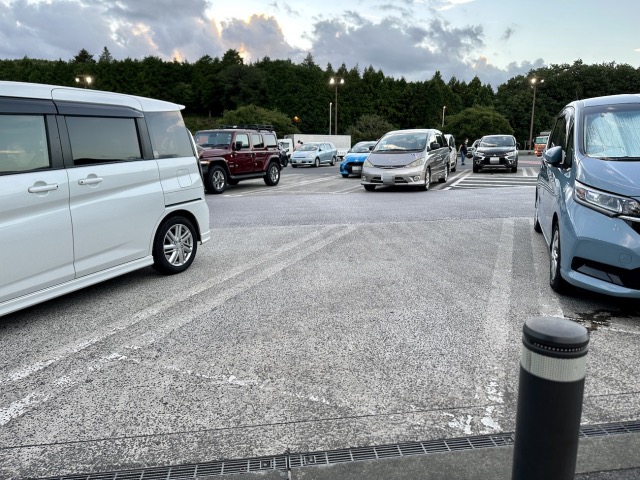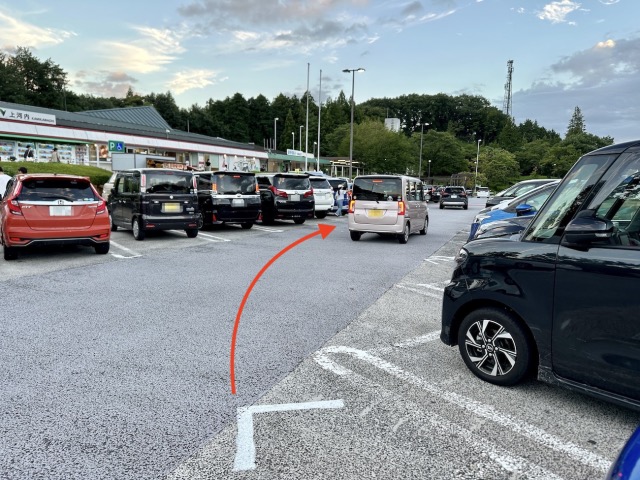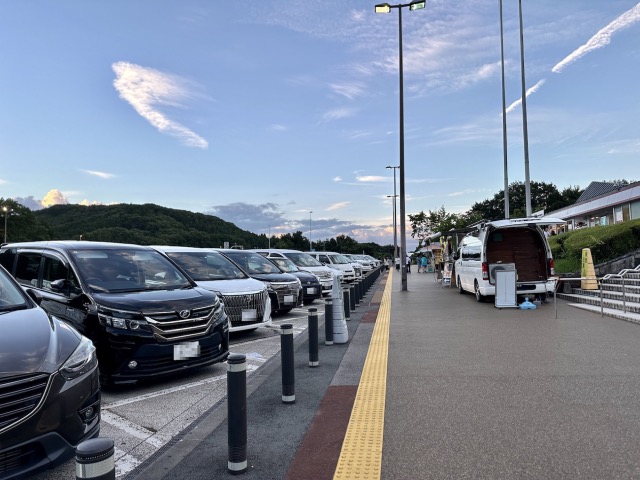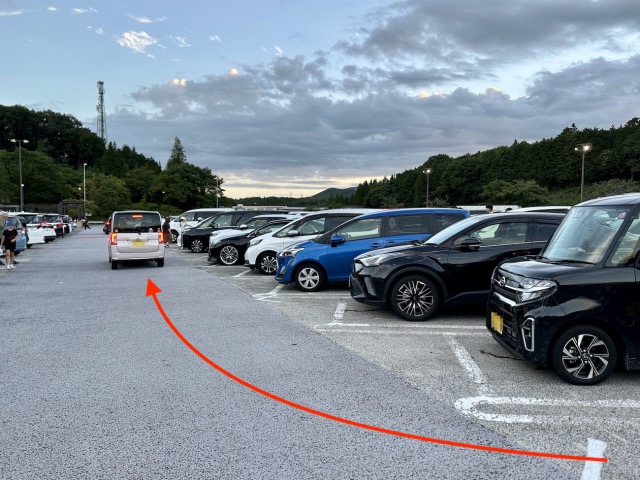
Clever design is a literal lifesaver.
If you’ve ever driven on a highway in Japan, you may have noticed that when drivers stop for breaks at the parking areas (PA) and service areas (SA), they have to park in angled spaces.
Angled parking like this is quite rare outside of these rest stops, so…why does it exist?
It’s a question that’s often puzzled our reporter Masanuki Sunakoma, but recently a friend cleared up the mystery for him, and now that he knows the reason behind the angled parking, he’s keen to share it with the world.
Apparently, the reason why a lot of highway rest areas use angled parking is to prevent drivers from driving in the wrong direction.
The angle of the parking spaces always faces the rest area exit, giving drivers only one choice of direction when they pull out of the parking space. While the direction of the exit might seem obvious to a lot of drivers, the angled parking is a failsafe way to ensure nobody makes the mistake of going back to the entrance instead. If even one car mistook the entrance for the exit, it could cause a head-on collision with cars entering the rest area, or, in an even worse scenario, they could make it out on to the highway again, only to drive straight into oncoming traffic.
With thousands upon thousands of cars and people on Japan’s highways every day, even one foolish mistake could have catastrophic results. So the angled parking is a literal lifesaver.
▼ Always only one way to go when you drive out of an angled space.
This revelation blew Masanuki’s mind, so he did a little more research, where he was able to confirm that the angled parking is utilised to prevent accidents. He also discovered some other benefits, as the design makes it easier for cars to enter and exit, and it helps to maximise the number of spaces in the parking lot.
If you’ve ever driven in or out of an angled spot, you’ll know how pleasant it can be — there’s no need to constantly check your mirrors and turn the steering wheel back and forth to straighten up like you would in a straight space, and the vehicle just seems to slide in and out with minimal effort, making it a relatively stress-free experience. It’s also a lot faster than getting in and out of a straight space, which helps to prevent congestion.
▼ Whee! See ya later!
The angle also helps to shorten the length between the front and rear ends, essentially creating more parking spaces while allowing both the vehicular and pedestrian thoroughfares in between to remain wide and easily accessible.
▼ Making the best use of limited space is something Japan excels in.
Utilising the area effectively also helps to ensure there are enough large spaces for vehicles like buses as well.
So there you have it — the reasons why Japanese highway rest stops have angled parking is to prevent accidents, stop congestion, make parking easier, and to fit more cars in, even in the busiest peak holiday periods.
It’s yet another example of world-class design that a lot of us in Japan take for granted every day. However, now that we know more about it, we have an even greater appreciation for Japanese highway rest stops…and their toilets that can measure fatigue levels.
Photos ©SoraNews24
● Want to hear about SoraNews24’s latest articles as soon as they’re published? Follow us on Facebook and Twitter!
[ Read in Japanese ]







 9 million yen awarded to convenience store from man for over 11,000 hours of unauthorized parking
9 million yen awarded to convenience store from man for over 11,000 hours of unauthorized parking Japanese convenience store demands ransom from owner of car parked illegally in its lot
Japanese convenience store demands ransom from owner of car parked illegally in its lot Aichi Police refund over a million yen in fines to drivers who violated a misplaced traffic sign
Aichi Police refund over a million yen in fines to drivers who violated a misplaced traffic sign Car crashes into Hiroshima 7-Eleven, owner gets guard rails, car crashes into gap in the rails
Car crashes into Hiroshima 7-Eleven, owner gets guard rails, car crashes into gap in the rails Huge torii gate found in the middle of a busy Kumamoto intersection
Huge torii gate found in the middle of a busy Kumamoto intersection Foreigner’s request for help in Tokyo makes us sad for the state of society
Foreigner’s request for help in Tokyo makes us sad for the state of society Japanese-style accommodation at the new Premium Dormy Inn hotel in Asakusa will blow your mind
Japanese-style accommodation at the new Premium Dormy Inn hotel in Asakusa will blow your mind Seaside scenery, history, and so many desserts on Yokohama’s Akai Kutsu【Japan Loop Buses】
Seaside scenery, history, and so many desserts on Yokohama’s Akai Kutsu【Japan Loop Buses】 Do Hi-Chew-flavor Hi-Chews have a reason to exist?【Taste test】
Do Hi-Chew-flavor Hi-Chews have a reason to exist?【Taste test】 Japan’s summertime towelket pillowcases are even better with the addition of Ghibli stars【Photos】
Japan’s summertime towelket pillowcases are even better with the addition of Ghibli stars【Photos】 Mikado Coffee is a 76-year-old coffee chain with a major celebrity connection
Mikado Coffee is a 76-year-old coffee chain with a major celebrity connection A trip to hell on Japan’s ‘vomit ship’: Is it as bad as everyone says it is?
A trip to hell on Japan’s ‘vomit ship’: Is it as bad as everyone says it is? After eight years as a NEET, our reporter shares the one thing that helped him escape that life
After eight years as a NEET, our reporter shares the one thing that helped him escape that life Haku is…Chihiro’s dead brother? Studio Ghibli fans blown away by Spirited Away theory
Haku is…Chihiro’s dead brother? Studio Ghibli fans blown away by Spirited Away theory French Fries Bread in Tokyo’s Shibuya becomes a hit on social media
French Fries Bread in Tokyo’s Shibuya becomes a hit on social media McDonald’s new Happy Meals offer up cute and practical Sanrio lifestyle goods
McDonald’s new Happy Meals offer up cute and practical Sanrio lifestyle goods Japanese ramen restaurants under pressure from new yen banknotes
Japanese ramen restaurants under pressure from new yen banknotes Red light district sushi restaurant in Tokyo shows us just how wrong we were about it
Red light district sushi restaurant in Tokyo shows us just how wrong we were about it New private rooms on Tokaido Shinkansen change the way we travel from Tokyo to Kyoto
New private rooms on Tokaido Shinkansen change the way we travel from Tokyo to Kyoto Tokyo Tsukiji fish market site to be redeveloped with 50,000-seat stadium, hotel, shopping center
Tokyo Tsukiji fish market site to be redeveloped with 50,000-seat stadium, hotel, shopping center Japanese city loses residents’ personal data, which was on paper being transported on a windy day
Japanese city loses residents’ personal data, which was on paper being transported on a windy day Beautiful Ghibli sealing wax kits let you create accessories and elegant letter decorations【Pics】
Beautiful Ghibli sealing wax kits let you create accessories and elegant letter decorations【Pics】 Secret Kitchen bento serves Japanese flowers, birds, wind and moon in a box, but is it worth it?
Secret Kitchen bento serves Japanese flowers, birds, wind and moon in a box, but is it worth it? New definition of “Japanese whiskey” goes into effect to prevent fakes from fooling overseas buyers
New definition of “Japanese whiskey” goes into effect to prevent fakes from fooling overseas buyers Our Japanese reporter visits Costco in the U.S., finds super American and very Japanese things
Our Japanese reporter visits Costco in the U.S., finds super American and very Japanese things Studio Ghibli releases Kiki’s Delivery Service chocolate cake pouches in Japan
Studio Ghibli releases Kiki’s Delivery Service chocolate cake pouches in Japan All-you-can-drink Starbucks and amazing views part of Tokyo’s new 170 meter-high sky lounge
All-you-can-drink Starbucks and amazing views part of Tokyo’s new 170 meter-high sky lounge More foreign tourists than ever before in history visited Japan last month
More foreign tourists than ever before in history visited Japan last month New Pokémon cakes let you eat your way through Pikachu and all the Eevee evolutions
New Pokémon cakes let you eat your way through Pikachu and all the Eevee evolutions Disney princesses get official manga makeovers for Manga Princess Cafe opening in Tokyo
Disney princesses get official manga makeovers for Manga Princess Cafe opening in Tokyo Sales of Japan’s most convenient train ticket/shopping payment cards suspended indefinitely
Sales of Japan’s most convenient train ticket/shopping payment cards suspended indefinitely Sold-out Studio Ghibli desktop humidifiers are back so Totoro can help you through the dry season
Sold-out Studio Ghibli desktop humidifiers are back so Totoro can help you through the dry season Japanese government to make first change to romanization spelling rules since the 1950s
Japanese government to make first change to romanization spelling rules since the 1950s Ghibli founders Toshio Suzuki and Hayao Miyazaki contribute to Japanese whisky Totoro label design
Ghibli founders Toshio Suzuki and Hayao Miyazaki contribute to Japanese whisky Totoro label design Doraemon found buried at sea as scene from 1993 anime becomes real life【Photos】
Doraemon found buried at sea as scene from 1993 anime becomes real life【Photos】 Tokyo’s most famous Starbucks is closed
Tokyo’s most famous Starbucks is closed One Piece characters’ nationalities revealed, but fans have mixed opinions
One Piece characters’ nationalities revealed, but fans have mixed opinions We asked a Uniqlo employee what four things we should buy and their suggestions didn’t disappoint
We asked a Uniqlo employee what four things we should buy and their suggestions didn’t disappoint Japanese toilets now measure fatigue levels at highway rest stops
Japanese toilets now measure fatigue levels at highway rest stops Drive recorder catches the moment a car flies into the front of an oncoming bus
Drive recorder catches the moment a car flies into the front of an oncoming bus What happens when you mistake the brake for the accelerator in Japan
What happens when you mistake the brake for the accelerator in Japan Driver struck by another vehicle in the wrong lane, still ordered to pay 40 million yen
Driver struck by another vehicle in the wrong lane, still ordered to pay 40 million yen Truck driver hailed as “hero” for cutting off car on wet highway
Truck driver hailed as “hero” for cutting off car on wet highway Should you drive through a red traffic light like this in Japan? Confusing road rule explained
Should you drive through a red traffic light like this in Japan? Confusing road rule explained Japanese toilet thrills motorsports fans at Suzuka F1 racing circuit highway service area【Video】
Japanese toilet thrills motorsports fans at Suzuka F1 racing circuit highway service area【Video】 Nissan unveils the world’s first “Intelligent Parking Chair”【Video】
Nissan unveils the world’s first “Intelligent Parking Chair”【Video】 Dead body found in car in parking lot in Japan, police say it may have been there over two years
Dead body found in car in parking lot in Japan, police say it may have been there over two years Japanese hospital threatens to stab owners of illegally parked cars with needles
Japanese hospital threatens to stab owners of illegally parked cars with needles “Conbini warp” an increasing traffic problem for businesses and authorities across Japan
“Conbini warp” an increasing traffic problem for businesses and authorities across Japan Elderly woman drives at speed on sidewalk in Japan 【Video】
Elderly woman drives at speed on sidewalk in Japan 【Video】 14 tips for visiting the Mt Fuji Shibazakura Festival, where beautiful “lawn sakura” blossom
14 tips for visiting the Mt Fuji Shibazakura Festival, where beautiful “lawn sakura” blossom A better use for your smartphone than Angry Birds: Remotely driving your car!
A better use for your smartphone than Angry Birds: Remotely driving your car! People wowed by Japanese road signs that change automatically in seconds 【Videos】
People wowed by Japanese road signs that change automatically in seconds 【Videos】
Leave a Reply